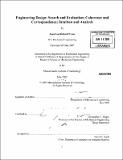Engineering design : search and evaluation; coherence and correspondence; intuition and analysis
Author(s)
Evans, Jonathan Richard
DownloadFull printable version (10.31Mb)
Other Contributors
Massachusetts Institute of Technology. Dept. of Mechanical Engineering.
Advisor
Christopher L. Magee.
Terms of use
Metadata
Show full item recordAbstract
This thesis discusses the engineering design process. Specifically, it addresses the methods and metrics used and motivation behind decisions made during the design process. The design process was divided along several "cognitive dimensions": search and evaluation, coherence and correspondence, and intuition and analysis. The effect of these dimensions on the design process and the effect of outside influences on them is the focus of this research. Several student design courses at the Massachusetts Institute of Technology were the basis for the observational aspects of the thesis. Both individual and team courses were followed. The students were studied as they progressed through the engineering design process using a combination of direct observational techniques, surveys and concept quizzes. The design process was found to be cyclical in nature. Students would cycle between search and evaluation, first finding potential ideas, then selecting ones for further investigation and then using results to find new ideas, and so on. The design process was also found to be progressive, shifting from coherence-aiming methods (usually more conceptual or theoretical) near the beginning of the process to more correspondence-aiming (usually experimental) at the end. Experience level (or perceived experience level) could influence this shift. Teams that felt more confident in their design abilities shifted later from coherence to correspondence based approaches than those that were less confident. (cont.) Deadlines also affected this shift, creating intermediary demands of either coherence or correspondence through the deliverables of prototypes, presentations, etc. The format of information representation (visual or numerical) and the requirements set forth (the questions asked) was found to influence whether intuitive or analytical thinking was more effective. In addition, conceptual understanding of engineering principles is theorized to be a more accurate measure of design ability potential than analytical understanding. Engineering education needs to account for these new dimensions of the design process.
Description
Thesis (S.M.)--Massachusetts Institute of Technology, Dept. of Mechanical Engineering, 2009. Includes bibliographical references (leaves 51-52).
Date issued
2009Department
Massachusetts Institute of Technology. Department of Mechanical EngineeringPublisher
Massachusetts Institute of Technology
Keywords
Mechanical Engineering.